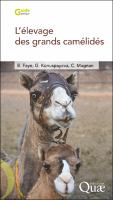L'élevage des grands camélidés
Author(s)
Faye, Bernard
Konuspayeva, Gaukhar
Magnan, Cécile
Language
FrenchAbstract
The ancestor of the large camelids, originally from North America, is thought to have migrated to Asia several million years ago, to settle in arid areas: the Arabian Peninsula for the dromedaries - also called Arabian camels or one-humped camels -, and Central Asia for the Bactrians - or two-humped camels, sometimes called Asian camels. The remarkable resistance of large camels to extreme climatic conditions, their service functions (transport, riding or management of pastoral areas), as well as the quality and good value of their products on national and international markets (milk, meat or wool), have led to the emergence over the last few decades of a new industry for these species, which until recently were confined to the subsistence of nomadic populations living in the desert regions of Africa and Asia. This industry is now being established not only in the countries of origin, but also in the Western world, where livestock management, based on practices implemented for the bovine species, often proves to be ineffective. This reference book, the only one of its kind in French, is therefore intended for all those involved in the industry, whether they are concerned with breeding activities, technical advice or the care of large camelids. It successively describes general information on the species, the physiological bases of reproduction, lactation and feeding, the main productions, as well as health and hygiene management in camel breeding.
Keywords
Africa; food; anatomy; Asia; biology; technical advice; breeding; ethology; Europe; industry; hygiene; milk; Mediterranean; nutrition; animal pathology; animal production; dairy product; reproduction; health; zootechnicsDOI
10.35690/978-2-7592-3500-1ISBN
9782759234998, 9782759235001, 9782759235018, 9782759234998Publisher
éditions QuaePublication date and place
2022Classification
Veterinary medicine: large animals


 Download
Download